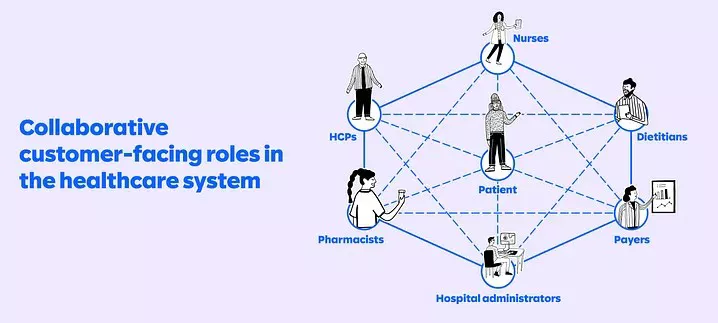Neugestaltung der Kundenbindung in der Pharma- und Medizintechnik

The COVID-19 pandemic accelerated digitization and revolutionized how healthcare and life science professionals consume information, creating a need for a more customer-centric approach to business operations. Digital epidemiology, for example, gained significant momentum during the pandemic enabling real-time monitoring and analysis of disease spread, its associated risk factors, and the impact of interventions like lockdowns, mitigating the burden of the pandemic. Through this historic event, the industry also experienced accelerated evidence generation with expedited drug approvals, Emergency Use Authorizations, and compassionate use of new and innovative therapies delivered to patients at lightning speed, saving and sustaining millions of lives across the globe.
While creating a powerful therapy and bringing it to market is essential, such innovative therapies are only useful when they reach the patient and make a meaningful impact on their life. Patient engagement should be a priority for every pharmaceutical and medical device/technology manufacturer–and understanding the patient journey is key to achieving this goal. By uncovering how and when patients connect with other stakeholders in the healthcare system, such as healthcare providers (HCPs) and payers, organizations gain a better understanding of who the customer is, what their needs are, and what role they play at each stage of the patient’s wellness journey.
The pharma customer evolution
The traditional model of pharma and med tech customer interaction focused primarily on physicians as the main decision-maker in prescribing medication. However, with the advent of multi-disciplinary care models (MDCM), the industry has shifted towards a more collaborative approach involving a variety of healthcare professionals such as nurses, dietitians, pharmacists, hospital administrators, patient advocates, and other allied health professionals, thereby evolving the definition of a pharma customer over the years. This evolution has been driven by the recognition that the patient journey is complex and requires a holistic approach that addresses the medical condition and the social, emotional, and financial factors that impact patient outcomes. As such, federal and private payers face increased pressures to reduce and contain costs. In addition to its clinical benefit, the MDCM has also been shown to reduce healthcare costs, especially in the care of chronic conditions, and it continues to gain momentum across healthcare stakeholders.
Additionally, customers today interact with businesses across multiple touchpoints, and each interaction presents an opportunity to provide a positive experience. However, in many cases, different departments (e.g., research and development, medical affairs, commercial, and patient services) operate in rigid silos, which can create disjointed customer engagement experiences.
With the paradigm shift towards an MDCM, engaging all stakeholders with the patient in the center is crucial for driving personalized care for each disease state.
 Graphic showing the collaborative customer-facing roles in the healthcare system
Graphic showing the collaborative customer-facing roles in the healthcare system
Customer journey mapping
Journey mapping can help organizations understand the needs, motivations, behaviors, and pain points at each stage of the disease-state life cycle for all customers (i.e., HCPs, patients, and payers) and create better, more informed decisions on what information and data to provide to who, how, where, and when.
By starting journey mapping early, pharma and med tech companies can uncover new opportunities to engage with patients earlier in their wellness journey–and ultimately improve their experience. Journey mapping enhances market conditioning efforts, making them more impactful as the who, where, what, how, and why are better defined. Gaining a deeper understanding of customer expectations allows companies to tailor their messaging and be delivered through the most beneficial medium for an individual. For example, affinity models allow insights into which customers respond better to peer-to-peer education versus non-personal promotion, and which customers engage better via social media, print media, or email. For those preferring social media, leveraging the right digital influencers, with the right campaign, on the right platform (e.g., LinkedIn, Instagram, Facebook, and TikTok) are essential in maximizing ROI and generating a greater script lift.
To prioritize patient-centric experiences, pharma and med tech firms must use journey mapping and data-driven insights to inform their customer engagement strategies. Understanding customer needs allows for tailored, clear, and helpful messaging, but it’s only one aspect of the equation. To truly improve the customer experience, businesses must adopt an omnichannel strategy that integrates data and enables a seamless experience for customers. This requires cross-functional collaboration across departments, starting with message alignment and open communication. By implementing an omnichannel approach, businesses can ensure that their messaging is consistent and targeted, regardless of the channel, building stronger relationships with higher target-audience engagement, increasing customer satisfaction, and driving better patient outcomes.
Implementing an omnichannel customer engagement strategy
An omnichannel customer engagement strategy provides a high-quality customer experience through the integration of various channels and touchpoints, giving the customer a consistent brand experience across all platforms, in-person and online. Pharma and med tech companies should adopt an omnichannel strategy to stay ahead of the competition and meet their customers where they are by effectively interacting with patients, HCPs, and payers. Achieving this transformation and improving the customer experience requires a shift in both customer-facing and internal operations.
Implementing an omnichannel strategy goes beyond messaging and channels to involve capabilities and processes. For example, businesses need to invest in pertinent technologies and tools that facilitate cross-channel communication and data integration. Additionally, businesses need to establish processes that allow for agile communication strategies that can adapt to evolving customer needs and preferences. The right customer relationship management systems, marketing automation software, and artificial intelligence tools personalize customer interactions while gathering data and insights across multiple channels to further inform and refine the strategy.
Conclusion
Delivering on the customer journey requires a comprehensive approach that prioritizes customer-centric messaging, cross-functional collaboration, and appropriate capabilities and processes to support that strategy. Pharma and med tech companies should prioritize patient and HCP engagement by creating patient-centric experiences that focus on their needs and expectations. This includes using customer journey maps, utilizing appropriate interaction channels, and considering the patient’s journey from before diagnosis to after treatment. It is crucial to emphasize on the needs of both patients and HCPs and determine the best communication channels to engage them. By prioritizing customer-centric messaging and cross-functional collaboration, pharma and med tech companies can ensure that they deliver on the customer journey and provide a positive experience for patients and HCPs. Ultimately, this will help companies build stronger customer relationships, increase engagement, and improve patient outcomes.


